Skin rashes can sometimes be very difficult to diagnose. A variety of common skin conditions can manifest as a skin rash. Skin rashes apart from the medical aspect are associated with social stigma as well.
The common Skin rashes can occur due to a variety of factors, including infections, heat, allergens, immune system disorders and medications.
A skin rash is not a specific diagnosis. Instead, it refers to any sort of inflammation and/or discoloration that distorts the skin’s normal appearance.
Following are some commonly encountered skin rashes:
Hives (Urticaria):
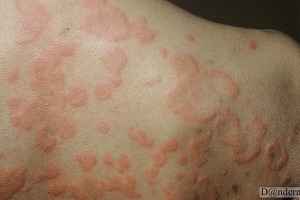
Hives look like welts and can itch, sting or burn. They vary in size and sometimes join together. They may appear on any part of you and last anywhere from minutes to days.
Causes include extreme temperatures, infections like strep throat, and allergies to medications, foods, and food additives. Antihistamines and skin creams can help.
Eczema is among the very common skin rashes:

One of the most common skin disorders that causes a rash is atopic dermatitis also known as eczema.
Atopic dermatitis is an ongoing (chronic) condition that makes skin red and itchy. Most often it appears as patches on the hands, feet, ankles, neck, upper body and limbs. It tends to flare up periodically and then subside for a time.
At-home interventions, such as avoiding harsher soaps and detergents or other irritants and applying creams or lotions, can lessen symptoms and reduce the risk of flare-ups. Medicated anti-itch creams or ointments also can lessen symptoms.
Christmas tree rash (pityriasis rosea) – a common cause of itchy skin rash:
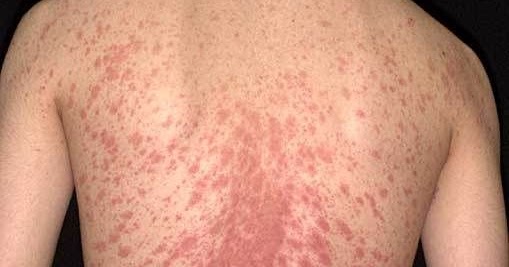
Christmas tree rash (pityriasis rosea) is a fine, itchy, scaly rash that usually appears first as a single patch on the chest, abdomen or back. After this first appearance (herald patch), the rash may spread as small patches to other parts of the back, chest, and neck.
The rash may form a pattern on the back that resembles the outline of a Christmas tree.
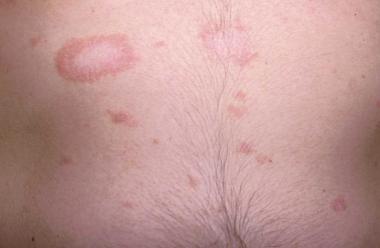
Pityriasis rosea usually goes away without treatment in four to 10 weeks, but it can last months. Medicated lotions may lessen the itchiness and speed the disappearance of the rash. Often, though, no treatment is required.
Allergic Contact dermatitis is among the common skin rashes

Contact dermatitis is a rash caused by direct contact with or an allergic reaction to certain substances. Irritant contact dermatitis usually produces a dry, scaly, non-itchy rash.
Many substances, such as cleaning products or industrial chemicals, that you come into contact with cause this condition. The irritant will cause a rash on anyone exposed to it, but some people’s skin may be more easily affected.
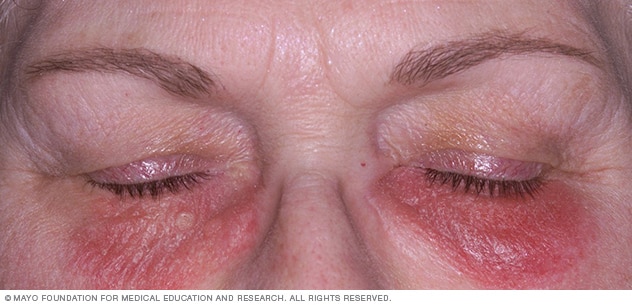
Allergic contact dermatitis produces a very itchy, red rash with bumps and sometimes blisters. Common allergy-causing agents (allergens) are latex rubber, nickel, and poison ivy. Allergic contact dermatitis develops after your initial exposure to the allergen.
To treat your rash, try to figure out what caused it and avoid that substance. You can also apply medicated cream to help improve symptoms.
Drug-induced rash/ Eruptions:
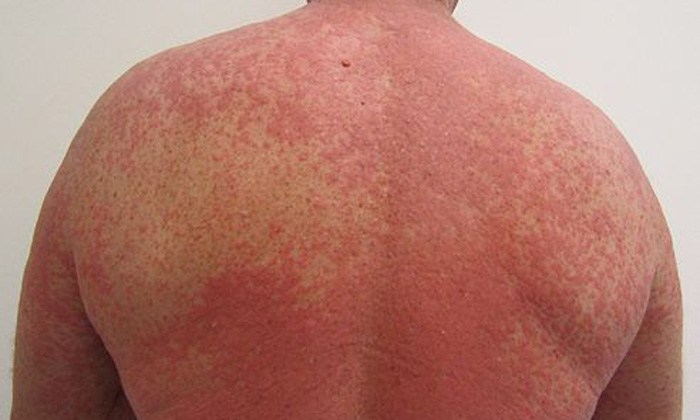
A rash may occur as a side effect of taking a drug or as an allergic reaction to it. A drug rash may be caused by many different medications, including antibiotics and water pills (diuretics). Some drugs are more likely to produce a rash if the skin is exposed to sunlight.
A drug rash, which usually starts within the first week of taking a new medication, often begins as red spots. The spots spread and merge, covering large areas of the body. If you stop taking the drug that caused the rash, it will usually clear up in days to weeks.
Rarely, a drug rash is part of a more serious, potentially life-threatening allergic reaction that affects the respiratory system and other organs. These severe reactions require emergency care.
Skin rash Diagnosis – Heat rash (miliaria):
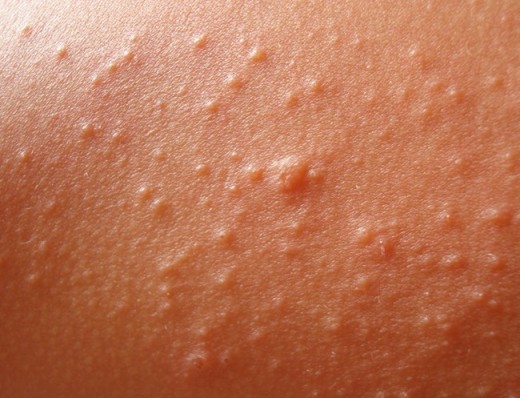
Heat rash (miliaria) occurs when the flow of sweat is obstructed, usually due to hot, humid weather or overdressing.
Prickly heat (miliaria rubra) is a type of heat rash that appears as clusters of small, red bumps that produce a pricking or stinging sensation. Miliaria crystalline appears as clear, fluid-filled bumps that generally produce no other signs or symptoms.
Heat rash isn’t serious and usually resolves when the affected area cools. Cool compresses or a cool bath might help. You can prevent heat rash by wearing loose, lightweight clothing and avoiding excessive heat and humidity.
Intertrigo:

Intertrigo is inflammation caused by skin-to-skin friction, most often in warm, moist areas of the body, such as the groin, between folds of skin on the abdomen, under the breasts, under the arms or between toes.
The affected skin may be sensitive or painful, and severe cases can result in oozing sores, cracked skin or bleeding.
Intertrigo usually clears up if you find a way to keep the affected areas as clean and dry as possible. Try wearing loose-fitting clothing and using powder to reduce skin-to-skin friction in affected areas. Weight loss may be helpful as well.
Sometimes, a bacterial or fungal infection can develop at the site of your intertrigo. If this happens, you may need medication to heal your skin.
Lichen planus:

Lichen planus is an inflammatory condition that can affect your skin and mucous membranes. On the skin it usually appears as purplish, often itchy, flat-topped bumps (lesions).
In your mouth, vagina and other areas covered by a mucous membrane, lichen planus forms lacy white patches.
The condition may develop gradually over a couple of months. After that, it rarely worsens, but it may persist for months or years.
You can usually control mild lichen planus symptoms on the skin, such as stinging and itching, by applying cool compresses or aloe vera gel.
More-severe symptoms may require drug treatment. Lesions on mucous membranes tend to take longer to heal and often recur.
Psoriasis is very common:

Psoriasis is the rapid buildup of rough, scaly skin that occurs when the life cycle of skin cells rapidly increases. The accumulation of dead skin cells results in thick, silvery scales and itchy, dry, inflamed patches that are sometimes painful.
The condition tends to flare up periodically and then subside for a time.

For some people, psoriasis is a mild nuisance. For others, it can be disabling, affecting extensive areas of skin for long periods and often occurring with a distinct type of arthritis (psoriatic arthritis).
Topical medications and light therapy may help reduce signs and symptoms of the skin lesions.
Ringworm of the body (tinea corporis):

Ringworm of the body (tinea corporis) is a fungal infection that appears as itchy, red, scaly, slightly raised, expanding rings like skin rashes on the body. The ring grows outward as the infection spreads, and the center area becomes less actively infected.
Ringworm is contagious. You can catch the infection through skin-to-skin contact with an infected person or animal or by coming into close contact with contaminated objects, such as unwashed clothing or bedding. Treatment usually requires prescription antifungal medication.

A tinea infection in the groin is called jock itch (tinea cruris), and a tinea infection of the foot is called athlete’s foot (tinea pedis).
Shingles (herpes zoster):
Shingles (herpes zoster) is a painful, blistering condition caused by the chickenpox (varicella-zoster) virus. If you’ve ever had chickenpox, the virus remains inactive in nerve tissue. Years later, the virus may reactivate, causing shingles.
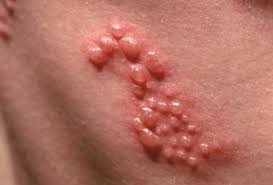
A shingles outbreak may start with vaguely uncomfortable sensations, itching or pain with no obvious external cause. Within several days, clusters of small blisters — similar to the chickenpox rash — appear in a defined area on one side of your body.
Over a few more days, the blisters break, leaving behind ulcers that dry and form crusts. Within about four weeks, the crusts fall off, and the pain and itching usually go away.
Antiviral drugs may lessen your pain or decrease the likelihood of persistent pain after the rash has healed. A shingles vaccine is recommended for most people age 60 or over.
Folliculitis:
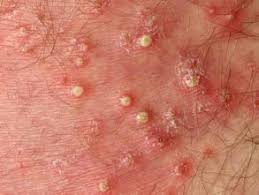
Folliculitis is inflammation within the wall of one or more hair follicles, creating a pustule. Different causes have been identified, including infection, trauma, friction, perspiration, and occlusion.
The most common infectious organism is S aureus, although gram-negative organisms have been found in patients on long-term antibiotic therapy, and Pseudomonas may be found in patients who use hot tubs or wetsuits.

Symptoms and signs may include pruritic skin rashes and pustules in hair-bearing sites, most commonly the face, scalp, neck, groin, and genital area.
The diagnosis is generally clinical; laboratory testing may be needed for treatment-refractory cases. Folliculitis is typically self-limited and does not require treatment, but the use of antibacterial soaps is recommended for recurrent folliculitis.
Treatment of deep lesions or those that are resistant to therapy includes topical and/or oral antibiotics with gram-positive coverage. Some cases may require antifungal drugs.
Cellulitis:
Cellulitis is a nonnecrotizing bacterial infection of dermis and hypodermis layers of skin. The most common organisms involved are Streptococcus pyogenes and Staphylococcus aureus.
Small breaks in the skin allow organisms to gain entrance to the dermis and multiply. In rare cases, particularly in immune-compromised patients like diabetes, hematogenous or metastatic seeding may occur.

Patients typically report fever, chills, pain, swelling, tenderness, erythema and warmth. The borders of cellulitis are not typically elevated or sharply demarcated.
In general, uncomplicated cases may not require laboratory studies, for more severe infections, obtain blood cultures ( or fluid cultures from lesions), complete blood count and other tests as needed.
Hand Foot and Mouth disease:
Hand-Foot-and mouth disease (HFMD) is a viral illness with oral and distal-extremity lesions. It is most commonly caused by coxsackievirus A16 and typically affects children and infants.
HFMD is highly contagious during the first week of infection and may lead to epidemics from direct contact with nasal or oral secretions or fecal material.

The incubation period typically averages 3-7 days. Symptoms include fever, rash, headache, sore throat, oropharyngeal ulcers, and loss of appetite.
The oral lesions are normally 2-3 mm vesicles on an erythematous base. Care is typically supportive, with antipyretics and anesthetics used for symptomatic relief.
Chickenpox:
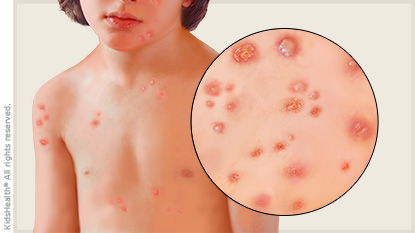
Chickenpox, caused by the varicella-zoster virus(VZV), which is highly contagious and acquired via inhalation of airborne respiratory droplets or direct vesicle contact.
This skin manifestation occurs in children younger than 10 years, generally appearing 10-21 days after contact with an infected person.
Skin rashes appear on the face, torso or scalp followed by the rest of the body.
The virus invades the capillary endothelial cells and epidermis, producing intercellular and intracellular edema and causing vesicle formation. The clear vesicles are surrounded by an erythematous halo. Lesions will subsequently develop central umbilication and crusting.
On examination, vesicles in all stages of development are typically present. The disease usually resolves spontaneously over 5-10 days.
Treatment is generally supportive. However, adults may have significant morbidity from systemic involvement and are often given antiviral medications as early as possible.
One should avoid aspirin ( associated with Reyes Syndrome) and ibuprofen (associated with severe secondary infections).
Melasma (Pregnancy Mask):

Melasma (chloasma) is tan or brown patches on your cheeks, nose, forehead, and chin. It’s often called the “pregnancy mask” because it happens in half of all pregnant women.
Men can get it, too. If it doesn’t go away on its own after the baby comes, you can treat it with prescription creams, over-the-counter products, or with laser treatments. Sunlight makes it worse, so always use a sunscreen.
Systemic Lupus Erythematosus:
In medicine, malar rash, also called butterfly rash, is a medical sign consisting of a characteristic form of a facial rash. It is often seen in lupus erythematosus but is not pathognomonic – it is also seen in other diseases such as pellagra, dermatomyositis, and Bloom syndrome.

The malar rash of lupus is red or purplish and mildly scaly. Characteristically, it has the shape of a butterfly and involves the bridge of the nose. Notably, the rash spares the nasolabial folds of the face, which contributes to its characteristic appearance.
It is usually macular with sharp edges and not itchy. The rash can be transient or progressive with the involvement of other parts of the facial skin.
A malar rash is present in approximately 46–65% of lupus sufferers and varies between different populations.
In such cases, the patient should urgently visit a hospital for further workup and management usually treated with steroids (topical and oral or systemic) analgesics, immunomodulators and immunosuppressive therapy.
Measles:

Measles is a highly contagious infectious disease caused by the measles virus. Symptoms usually develop 10–12 days after exposure to an infected person and last 7–10 days.
Initial symptoms typically include fever, often greater than 40 °C (104.0 °F), cough, runny nose, and inflamed eyes. Small white spots known as Koplik’s spots may form inside the mouth two or three days after the start of symptoms.
A red, flat rash which usually starts on the face and then spreads to the rest of the body typically begins three to five days after the start of symptoms. Complications occur in about 30% of cases and may include diarrhea, blindness, inflammation of the brain, and pneumonia, among others.
Rubella, which is sometimes called German measles, and roseola are different diseases caused by unrelated viruses.